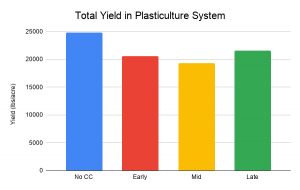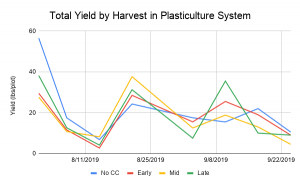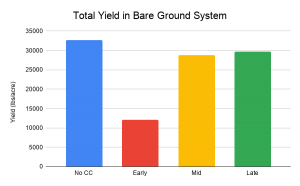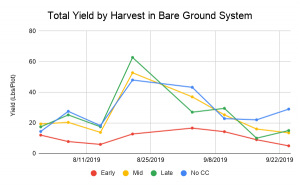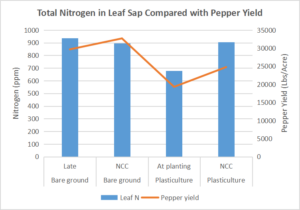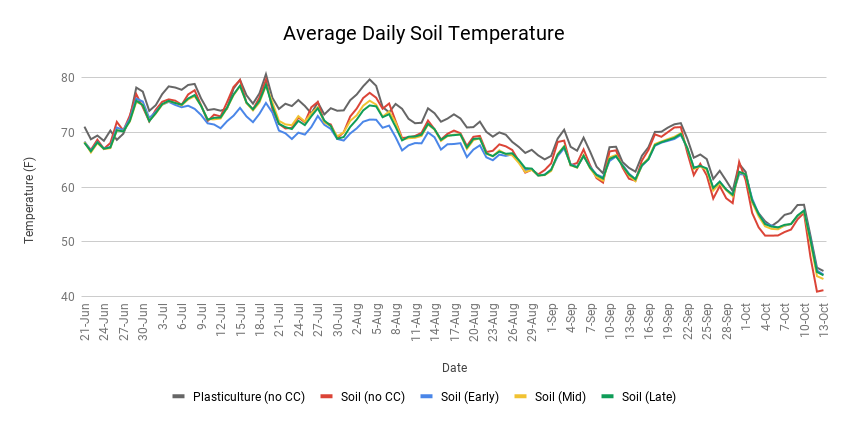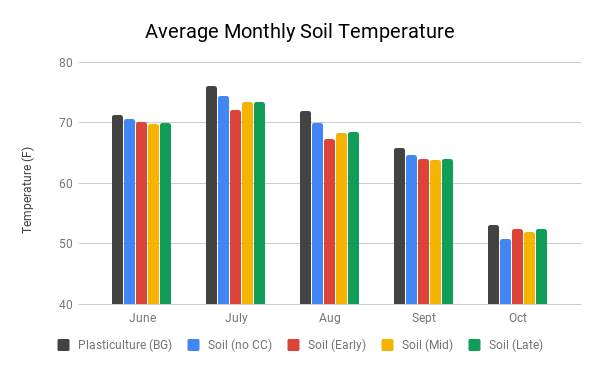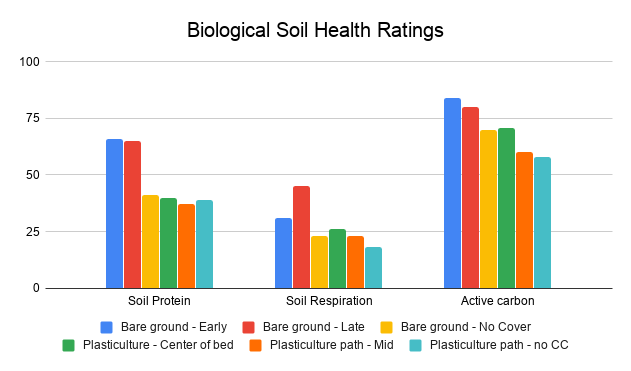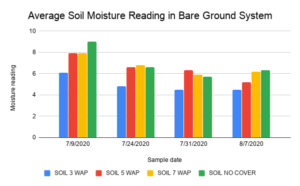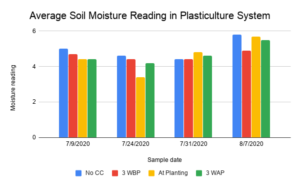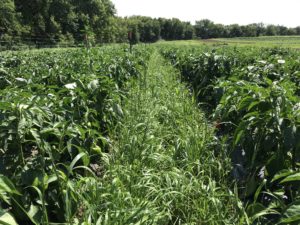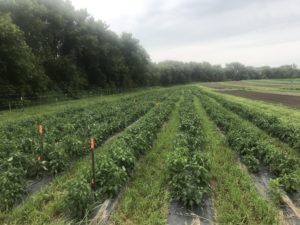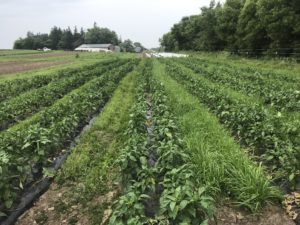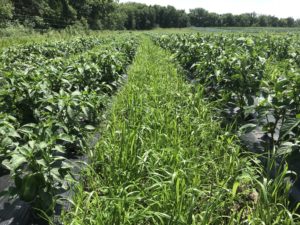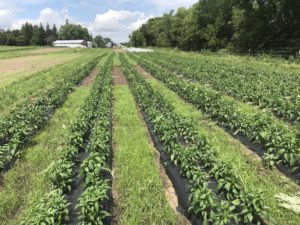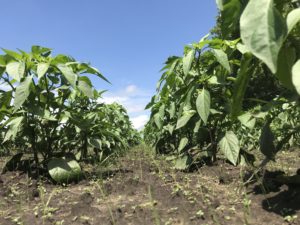Final report for FNC19-1171
Project Information
Sogn Valley Farm is an organic vegetable farm and plant nursery operating on 25 acres with three greenhouses. We grow diversified vegetables for a farmer's market and farm share program, and also grow peppers, tomatoes, watermelon, and smaller amounts of other crops for wholesale accounts. Our annual vegetable production acreage hovers around 12-13 acres. We employ seven people full-time and three people part-time during the growing season, with 1-3 continuing to work through winter. We have been certified organic since our first growing season, and have always used cover crops and planted pollinator habitat in and around our vegetable fields.
Peppers are a high-value and widely grown crop among vegetable growers in the Midwest. Many growers, myself included, plant peppers on plastic mulch because of its soil warming, moisture retention, and weed suppression benefits. While an effective tool for us, the waste generated through its disposal doesn’t align with our sustainability goals.
A major factor preventing us from discontinuing use of plasticulture is controlling weeds once plants become too large for mechanical cultivation, which can be more than a 2-month period for this long-season crop. For both plasticulture and bare ground systems, harvest is typically not completed until mid-October, at which point cover crop options are limited and unlikely to produce meaningful growth.
This project evaluated interseeding of cover crops at various dates into an established pepper crop using both plasticulture and bare ground systems. We did this through field-scale plots set up within our production field. The treatments were not replicated, as our goal was for this to be assessed within a production environment to evaluate ease-of-implementation for commercial farmers. Consequently, some plot-to-plot variability could have contributed to differences among treatments, so this should be kept in mind when drawing conclusions.
We found some reduction in yield when an interseeded cover crop was present, around 10-12% in the bare ground system and 13-22% in the plasticulture system. However, overall yields were still quite good compared to historical averages. Given the other benefits from the cover crop, we feel the system has promise and plan to continue experimenting with interseeded cover crops in pepper fields in future seasons. We also found that, while plastic mulch did lead to earlier harvest, the overall yields were actually lower than those in the bare ground plots. We did find a reduction in soil temperature where an interseeded cover crop was present, but the insulative properties of the surface vegetation actually maintained warmer temperatures during cool temperatures in the fall. We saw improvements in biological soil health indicators when cover crops were present in bare ground plots, but no improvement in aggregate stability. The poorest biological soil health was observed in the plasticulture path, with and without a cover crop, likely because topsoil was moved into raised beds during bedshaping.
As commercial organic vegetable farmers, we were keenly interested in the potential for interseeded cover crops to extend our cover cropped acreage into long-season crops like peppers, and feel excited about continuing to experiment with this system. We will likely continue using Dutch white or medium red clover, but seek out a different grass species to mix with it given the rapid seedhead production observed with annual ryegrass. The establishment and maintenance of the cover crop did not feel onerous, and we appreciated the presence of the cover crop keeping our plants clean from soil splash and allowing us to harvest after heavy rain events without going ankles deep in mud.
- Compare plasticulture and bare ground production systems in terms of yield, ease of management, and suitability for cover crop interseeding.
- Determine which cover crop sowing date optimizes both cover crop growth and cash crop yield.
- Monitor environmental co-variables (soil temperature and moisture), crop nutrients, and cover crop biomass to help explain treatment effects on cash and cover crop growth.
- Quantify soil health benefits of cover crop interseeding through the multifaceted Cornell CASH (Comprehensive Assessment of Soil Health) test.
- Provide a production-scale demonstration of cover crop interseeding for farmers through a field day and photos.
Cooperators
- (Researcher)
- (Researcher)
Research
Experimental design and treatments: For each production system [plasticulture or bare ground (BG)] one 40x200’ field was divided into four (40’x40’) plots and a treatment was randomly assigned to each plot. For plasticulture, treatments consisted of cover crop (CC) interseeded 3 weeks before planting (Early), at planting (Mid), or 3 weeks after planting (WAP) (Late), or no cover crop (NCC). For BG, treatments were CC interseeded 3 WAP (Early), 5 WAP (Mid), 7 WAP (Late), or NCC. Data was collected from two representative subplots within each treatment plot - 40 plants per subplot x two subplots = 80 plants per treatment plot.
Cover crop management: A mixture of annual ryegrass and Dutch white clover was sown at a rate of 30 lbs/A (20lb/A ryegrass, 10lbs/A clover). In the plasticulture system, CC was seeded in the pathway between beds using a walk-behind drop spreader. (A 36" wide Gandy drop seeder was used, making it a bit wider than the pathway between beds. We felt it was important to get seeds all the way to the edge of the plastic mulch so we didn't end up with a bare strip along the bed that would be prone to growing weeds. The more commonly available 24" or narrower spreader would not have fully covered the pathway.) In the BG system, CC was seeded using a broadcast spreader to throw seed within the bed. For all treatments, seed was surface sown, and in one case overhead irrigated to encourage rapid germination and establishment. After all other seeding events, we received rain within a couple days, so no irrigation was used to germinate the cover crop.
Crop management: Pepper transplants were grown in plug trays in a greenhouse and hardened off for a week prior to transplanting. Transplanting and other field operations are detailed in the proposal's Activities table. The pepper crop was managed using our current practices and fertilized with Sustane 8-2-4 at 80 lbs N/acre, applied before tilling in BG system or during mulch laying in plasticulture system.
Data collection: Marketable green pepper yield per harvest, soil moisture (semi-weekly), soil temperature (continuous), plant sap nutrient concentration (1x/yr), soil health (early October), and cover crop biomass (after last harvest).
Pepper Yield
We harvested green bell peppers from the data plots, sorting out obvious culls as we went. While I'll refer to these are "marketable yield," there were likely some more culled during wash and pack, so the actual amount sold was a bit less. This was not quantified.
Effects of cover crops in plasticulture system
We did see a reduction in yield when cover crops were interseeded between beds, ranging from a 22% loss at the Mid seeding date to 13% loss at the Late date. We had hoped to maintain yields in interseeded plots, but are still encouraged by the results. To us, a 10% drop in yield is not too consequential given the benefits we get from the cover crop: soil erosion protection, cleaner fruit, ability to harvest after heavy rain events, and some active cover crop going into the winter.
I cannot explain why yield in the Early plots was higher than Mid, since there would have been earlier competition with the cash crop. Anecdotally, I will mention a few things that might explain this result. First, we overhead irrigated the Early plot to establish the cover crop, and it was our first time using our new Kifco water reel. We ended up having a faulty part that caused the nozzle to retract very slowly, resulting in 2-2.5" of water being put down on that plot in a short period of time. This created some puddling and washed most of the CC seeds from the shoulder of the beds down to the center of the pathway. Thus, there was less cover crop growing along the shoulders of the beds, where they'd be most likely to compete with the cash crop. Second, while the Early plot CC did germinate the earliest, cool conditions prevented it from rapidly growing in late April/early May. By early June, we couldn't notice any difference in cover crop growth between the Early and Mid dates, even though Early was seeded three weeks earlier. I suspect any difference in yield between these two plots has more to do with plot-to-plot variability unrelated to the CC treatments.
Looking at the yields per harvest, we found a big flush at first harvest followed by much smaller amounts the next two harvests. This may have been due to harvesting some smaller peppers that would have set back subsequent harvests. The crew members were still getting trained to pick only the large, thick walled peppers, and may have overpicked.
These results suggest that seeding the cover crop a few weeks after transplanting the cash crop may minimize yield loss from CC competition with the cash crop. We have other anecdotal evidence of this from other production fields on our farm that weren't part of the study. We decided to go ahead and interseed all of our other plasticulture peppers in mid-July with the same cover crop mixture. While we didn't have a control to compare against, all these peppers (bell and hot types) produced very high yields and did not seem to be adversely affected by the cover crop. It's also important to note that our yields in all treatments were on par with industry standards and our historical yields of ~20,000-25,000 lbs/acre.
Effects of cover crops in bare ground system
Similar to the plasticulture results, the NCC plots had somewhat higher yields than the Mid and Late CC plots, but in this case there was only a 10-12% difference. The Early plot experienced substantial cash/cover crop competition, which was evident long before we began harvest, so yields were very low in that plot.
Note: The yield results from the Mid plot should be taken with caution - there was a personnel error during cover crop management, and that cover crop was mistakenly cultivated two weeks after planting. While some of the cover crop re-established and continued growing, it was probably at 50% cover and thus isn't representative of the intended cover crop treatment.
What we take from this is that interseeding three weeks after transplanting in this bare ground system - where the cover crop is covering the entire field and intermingling with crop plants - is too early. The late planting date (7 weeks after transplanting) seemed to minimize competition and maintain what I would consider acceptable yields. We plan to continue using this technique in at least some of our bare ground pepper fields in the future. I wish we had gotten a full stand from the Mid seeding date to see if it would have impacted yield.
The downside to seeding the cover crop later in the season is that it requires regular weed control up until that point. We typically cultivate every 10-14 days, so 3-4 cultivation passes may be necessary before interseeding the cover crop 7 weeks after transplanting.
Effects of plasticulture vs. bare ground (independent of cover crop)
One surprising and encouraging finding was that plastic mulch did not increase overall yield; we actually had slightly higher yield from the bare ground NCC compared with the plasticulture NCC plot. I will qualify that with three other comments. First, plasticulture did have much higher yields from the early harvests, so if earliness is critical for markets, plastic mulch may warrant use. Second, we were harvesting peppers at the green stage, which require fewer days to maturity than ripe peppers. We plan to continue using plastic mulch on our bell peppers intended for ripe harvest, along with our long-season Capsicum chinense species hot peppers. However, we plan to switch to bare ground production for green bell peppers, and earlier hot pepper varieties such as Anaheim and serrano. Third, we have a Kult-Kress fingerweeder that can quickly and effectively control in-row weeds with cultivation. For growers without good weed control tools, plastic mulch may remain an attractive option for weed control.
Nitrogen Competition
We hypothesized that potential nitrogen competition between the cover crop and pepper plants could lower yields where a cover crop is present. In late August, we sampled leaves to be analyzed for sap nutrient levels. The chart below shows Total N in leaf sap (blue bars) compared with the total yield from the plot (orange line). We found that the total nitrogen levels within the leaf sap were somewhat correlated with marketable pepper yield. While we don't have enough data to say that nitrogen competition caused the yield differences, it does suggest that additional nitrogen fertilization may be an option to counteract nitrogen competition and improve crop yield when using interseeded cover crops.
Soil temperature
Through hourly soil temperature readings at 4" depth, we have robust data on soil temperature during the season. Since we were concerned with in-row soil temperature, we only took readings in the NCC plasticulture plot in addition to all four plots in the bare soil system. We didn't think a cover crop growing in the pathway would affect in-row soil temperature under plastic mulch.
Soil temperatures varied among treatments as expected. The highest soil temperature occurred in the plasticulture system, followed by bare soil without a cover crop. Interseeding a cover crop in the bare ground system reduced average soil temperature by 1.5-2 °F in July and August, with earlier cover crop establishment leading to lower temperatures. The trend was reversed in late September and October, when the lack of surface cover (which has insulative properties) led to a faster drop in soil temperature as air temperature declined in the late season.
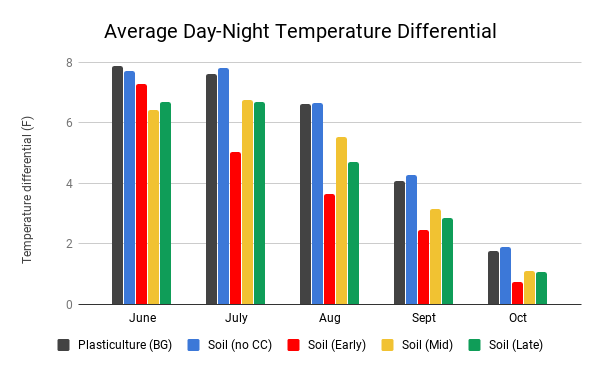
This last chart shows the average day-night differential, the swing in temperature from 8pm to 8am. Note that the lack of cover crop resulted in the greatest temperature swing overnight.
Soil health
Biological soil health metrics (soil protein, soil respiration, active carbon) were highest in interseeded bare ground plots (Early and Late), as we had hypothesized given the presence of the cover crop. The NCC pathway in plasticulture trended lowest. Surprisingly, the interseeded pathway in the plasticulture system had one of the lowest soil health ratings. Despite having robust above ground growth, the paths were quite compacted from tractor operation and foot traffic. Another factor is the lack of microbially active topsoil, since forming raised beds moves this soil out of the pathway and into the bed.
While we did not see improvements in physical soil health attributes (e.g. aggregate stability, which was poor in all plots), we are encouraged by the biological response where a living cover crop co-mingles with the crop. Soil physical properties may take years to improve given the fairly intense tillage we've done over the last five years, but these biological improvements could have immediate benefits to the crop. And while measuring it was beyond the scope of this project, we know that the presence of the cover crop reduced soil erosion from wind and water.
Soil moisture
Soil moisture was measured manually using a probe on four dates over the course of the season. The data displayed below are the average of five readings per plot on each date. Because these were not continuous data loggers, they only measure a snapshot in time, and the probe isn't a price research-grade tool. Differences among treatments would have been somewhat masked by irrigation that we applied, particularly to the plasticulture field.
With that said, there are some takeaways. The most consistent effect we saw was lower soil moisture in the Early bare ground plot, which had the most vigorous and competitive cover crop. The NCC plots in both plasticulture and bare ground systems had the highest, or among the highest, soil moisture throughout the year. This is what we would expect, since there is no cover crop to draw water from the soil.
Overall, there wasn't a striking difference in soil moisture between the NCC and cover cover crop plots, with the exception of the Early CC plots in the bare ground system. More frequent samples would be needed to better understand the moisture dynamics in this system, but the continued use of irrigation in our production setting might continue to reduce moisture competition from the cover crop.
Cover crop biomass
After completing harvest, we collected above ground cover crop biomass and dried and weighed them. Biomass was similar among treatments, ranging from 2,500-2,800 lbs/acre on a dry-weight basis. Since the plasticulture system only had cover crop in the pathways, the actual biomass per acre would be proportional to its percent cover (30-40%).
These samples were taken at the end of the season, after 2-4 mowing events in the plasticulture plots and 1 mowing in the Early bare ground plot, so there was likely even more biomass production in those plots.
Plot photos:
Educational & Outreach Activities
Participation Summary:
Our primary outreach contribution was our field day in August of 2020 which attracted ~50 attendees and featured three on-farm experiments in collaboration with two agriculture professionals. We explained the background of our project and attendees saw the interseeded pepper fields up close and personal.
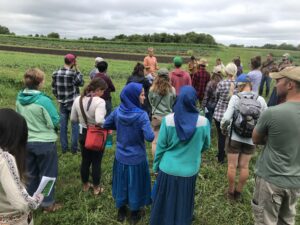
We have also done additional informal tours and consultations with other farmers interested in incorporating living cover crops into their production fields. Some of these were phone calls, others visited the farm in person.
I presented my project and results at the Northern Plains Sustainable Agriculture Conference in January 2020.
I also presented at the 2021 Growing Stronger Conference in late February.
Lastly, I presented to a Land Stewardship Project-led farmer meeting in early March 2021 centered on reducing tillage/climate change.
I wrote an article that was published in the MOSES Organic Broadcaster in March 2021.
Learning Outcomes
We had considered interseeding cover crops on many occasions over the last few years, but had not found/made the time to trial it until this experiment. It now feels far less intimidating experimenting with different cover crops in peppers and other crops.
I learned that annual ryegrass regularly goes to seed, and that this results in not only taller growth than desired, but also seed production. We will no longer be planting annual ryegrass before August, except for short-term plantings where it is terminated prior to seedhead production.
I got a feel for the relative growth rates of the clover/ryegrass cover crop, and the amount and timing of canopy formation of the pepper cash crop. This gives me ideas for tweaking the system moving forward. Here are some of the things I'm playing around with:
- Creeping red fescue instead of annual ryegrass, in clover mixture. This is not a widely used grass species in agriculture, but has growth characteristics that warrant examination.
- Possibly spring-seeded winter rye in a clover mixture. As long as it is not exposed to freezing temperatures, rye should not go to seed and thus remain short-statured, which is desirable in this case. The larger seeds may not establish as well surface sown as the smaller-seeded annual ryegrass and clover.
- Buckwheat as nurse crop for clover in plasticulture pathways? Buckwheat rapidly canopies over, allowing for clover to germinate and establish without weed competition. Could increase seeding rate of clover so it suppresses weeds once established. If seeded just before pepper transplanting, the buckwheat should be flowering by early July, just before pepper harvest begins. It could then be mowed off with a heavy duty walk behind mower, or possibly even just crimped by driving over with tractor tires. Then the clover would come up through.
- Crimson clover instead of dutch white clover where winterkill of cover crop is preferable. Crimson clover will grow taller than Dutch white and will not be as traffic- and shade-tolerant, but should establish more quickly with its larger seed size.
- If interseeding between plastic mulch, just broadcast the seed across the whole field prior to planting (while there are no holes in the plastic). The seeds will blow off the plastic with a little wind, or they could be blown off with a leaf blower. This would be faster and easier than using the drop spreader.
- To interseed plasticulture pathways later in season after plants are large, drill holes in the bottom of a 7-gal water jug and walk down the rows shaking it. Very simple but quite effective. See video of this here: Seeding cover crop with water jug
- We may have seen some increase in rodent damage to pepper fruits in bare ground plots with heavy interseeded cover crop, since the cover crop provides cover/habitat. Just something to consider.
Project Outcomes
See Learning outcomes section for ideas for changes to this system, many of which could warrant an additional SARE project.
